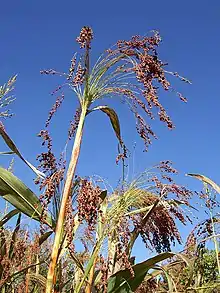Sorghum arundinaceum
Sorghum arundinaceum, the common wild sorghum, is a species of flowering plant in the family Poaceae.[2] It is native to Sub‑Saharan Africa, Madagascar, many of the Indian Ocean islands, and the Indian Subcontinent, and has been introduced to northern South America, the US states of California and Florida, Puerto Rico, Taiwan, New Guinea, and a number of smaller islands worldwide.[1] It is the wild progenitor of cultivated sorghum, Sorghum bicolor, with some authorities considering it to be a mere variety or subspecies; Sorghum bicolor var. arundinaceum, or Sorghum bicolor subsp. verticilliflorum.[3][1]
| Sorghum arundinaceum | |
|---|---|
 | |
| Habit | |
| Scientific classification | |
| Kingdom: | Plantae |
| Clade: | Tracheophytes |
| Clade: | Angiosperms |
| Clade: | Monocots |
| Clade: | Commelinids |
| Order: | Poales |
| Family: | Poaceae |
| Subfamily: | Panicoideae |
| Genus: | Sorghum |
| Species: | S. arundinaceum |
| Binomial name | |
| Sorghum arundinaceum | |
| Synonyms[1] | |
|
List
| |
References
- "Sorghum arundinaceum (Desv.) Stapf". Plants of the World Online. Board of Trustees of the Royal Botanic Gardens, Kew. Retrieved 29 July 2021.
- Registry-Migration.Gbif.Org (2021). "Sorghum arundinaceum (Desv.) Stapf". GBIF Backbone Taxonomy. Checklist dataset. GBIF Secretariat. doi:10.15468/39omei. Retrieved 29 July 2021.
- Cunniff, Jennifer; Osborne, Colin P.; Ripley, Brad S.; Charles, Michael; Jones, Glynis (2008). "Response of wild C4 crop progenitors to subambient CO2 highlights a possible role in the origin of agriculture". Global Change Biology. 14 (3): 576–587. Bibcode:2008GCBio..14..576C. doi:10.1111/j.1365-2486.2007.01515.x. S2CID 86252670.
This article is issued from Wikipedia. The text is licensed under Creative Commons - Attribution - Sharealike. Additional terms may apply for the media files.